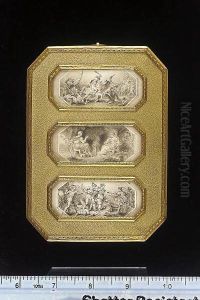Nathaniel Marchant Paintings
Nathaniel Marchant was an English gem engraver and medallist born in 1739 in the town of Linton in Cambridgeshire, England. He is recognized for his exquisite work in intaglio, a process involving the carving of designs or images into precious stones, a practice with ancient origins that enjoyed a revival during the neoclassical period in which Marchant worked.
Marchant developed an interest in the arts at a young age and was apprenticed to a seal engraver in London. He honed his skills in this discipline, becoming adept at carving fine details into small surfaces. In 1766, he enrolled in the newly established Royal Academy of Arts in London, where he studied under renowned artists and expanded his knowledge and technical ability in engraving.
With a desire to deepen his expertise and inspired by the classical art of the Mediterranean, Marchant traveled to Rome in 1772. There, he was exposed to the grandeur of ancient art and the works of contemporary gem engravers. He spent several years in Rome, studying ancient gems and perfecting his craft, and he became prominent in the field for his classical style and the delicacy of his work.
During his time in Italy, Marchant produced some of his most significant works, including gem portraits of British tourists and copies of ancient intaglios. His reputation grew, and he was patronized by several notable figures of the time, including Catherine the Great of Russia. Marchant's intaglios were sought after for their beauty and the skill with which he executed them, making him one of the most celebrated gem engravers of his era.
Marchant returned to England in the early 1780s and continued to work as an engraver. He was appointed gem engraver to King George III in 1786, a prestigious position that acknowledged his status as a leading artist in his field. Marchant's work during this period included a series of intaglios of the king and other members of the royal family. In addition to his work with gems, Marchant also produced a number of medals, further showcasing his versatility and skill as an engraver.
Nathaniel Marchant's contribution to the arts was significant, as he helped to revive the ancient practice of gem engraving and brought it to new heights during the neoclassical period. His works were characterized by their fine detail and adherence to the classical ideals of beauty and proportion.
Marchant passed away in 1816, leaving behind a legacy as one of the finest gem engravers of his time. His work is still admired today by collectors and connoisseurs of classical and neoclassical art, and his pieces are held in various museums and private collections around the world. Marchant's influence extended beyond his lifetime, as his commitment to craftsmanship and the classical tradition continued to inspire artists in the generations that followed.
